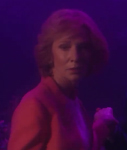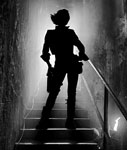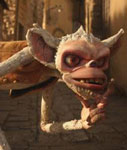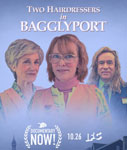Hi, Blanchett fans!
Cate has signed up to do another TV series which will be directed by Alfonso Cuarón. The cast of Don’t Look Up, where Cate plays Brie Evantee, has been nominated for Best Ensemble at Hollywood Critics Association. Nightmare Alley had it’s world premiere at Alice Tully Hall in New York last night. Unfortunately, Cate is not able to attend the red carpet premiere but she popped in for the Q&A after the screening. You can see the videos and photos plus the reviews and reactions on the movie below. Enjoy!
Special thanks to Cate Blanchett fans on CBF Chat for the links!
Cate Blanchett & Kevin Kline To Star In Alfonso Cuarón Thriller Series ‘Disclaimer’ For Apple
Alfonso Cuarón is adapting Renee Knight’s novel Disclaimer as a series for Apple TV+ with Cate Blanchett and Kevin Kline starring.
The project marks the first series from the Roma filmmaker since he signed an overall deal with the streamer in 2019. It also marks a series debut for Sophie’s Choice and A Fish Called Wanda star Kline.
Cuarón to write, direct and executive produce all episodes of the series, marking the first time that he has written and directed all episodes of an original series. Blanchett also exec produces.
Blanchett plays Catherine Ravenscroft, a successful and respected television documentary journalist whose work has been built on revealing the concealed transgressions of long-respected institutions. When an intriguing novel written by a widower, played by Kline, appears on her bedside table, she is horrified to realize she is a key character in a story that she had hoped was long buried in the past. A story that reveals her darkest secret. A secret she thought was hers alone.
Disclaimer is produced by Cuarón’s Esperanto Filmoj and Anonymous Content. Academy Award-winner Emmanuel Lubezki (Gravity) and Academy Award nominee Bruno Delbonnel (The Tragedy of Macbeth) will serve as directors of photography on the project. Cuarón serves as executive producer alongside Esperanto Filmoj’s Gabriela Rodriguez and Anonymous Content’s David Levine, Dawn Olmstead and the late Steve Golin. Renee Knight serves as co-executive producer.
— Deadline
Don’t Look Up Nomination
The nominees for Best Cast Ensemble are:
#Belfast#CODAFilm #DontLookUp #KingRichard #TheHarderTheyFall #HCAFilmAwards #BestCastEnsemble #BestCast pic.twitter.com/GYdWmfAOdA— Hollywood Critics Association (@HCAcritics) December 2, 2021
Nightmare Alley Post Screening Q&A, Reviews and Reactions
Guillermo Del Toro’s Carnival Noir Is Stylish As Hell, With A Standout Cate Blanchett Performance
As good as the first half of “Nightmare Alley” may be, it really comes to life when Lilith shows up, played by Cate Blanchett. Blanchett was born to be a femme fatale in a film noir, and del Toro knows it. Dan Laustsen lights her in a consistently alluring way — there are multiple shots where the top half of her head, including her eyes, are bathed in shadows, and those shadows follow her around as if she had control over them. And from that darkness, those eyes sparkle with menace. Blanchett, with her deliberate way of speaking and the seductive way she breathes cigarette smoke, is simultaneously hot as hell and icy cold, and everything she does here is dynamite. She’s pretty poison in an ornate bottle.
As sumptuous as all of this is, “Nightmare Alley” does suffer from problems of pacing. Blanchett’s introduction to the film is so fierce that when the film starts focusing on anyone other than her, the story starts to feel like it’s dragging. Stan’s con game with Ezra goes on a little too long (although it’s worth noting it goes on even longer in the book), and del Toro and Morgan’s script fails to make this section of the story particularly interesting. At least not at first. However, “Nightmare Alley” does manage to eventually right itself, heading into a climax bursting with brutal violence and shocking twists. More than that, it’s all building up towards an ending that burns its way into your very soul. Without giving anything away, let me just tell you the final shot of this movie is an all-timer, and even if the film as a whole doesn’t work for you, I’m confident you’ll walk out of the theater haunted by those last moments.
— Full review on Slashfilm
Bradley Cooper disappears as Nightmare Alley’s lead, but Cate Blanchett is the true stunner
Commanding the role in its various phases, Bradley Cooper’s character is pushed in some ways we’ve seen before in Nightmare Alley, but it’s delivered with the actor aligning the ferocity we’ve seen him exhibit previously along with key doses of restraint. And yet, when it comes to the true stone cold stunning talent of this poisonous drama, you need not look further than Cate Blanchett’s Dr. Lilith Ritter.
Blanchett and Cooper’s pairing is one of the cinematic joys of 2021, as right from their first moments together on screen it’s absolutely what you would have expected and hoped for. The audience is going to obviously go into this movie with ideas in regard’s to Lilith’s motivations in Nightmare Alley, but whether those notions are fulfilled or not is incidental, as Blanchett’s pitch perfect performance supersedes such matters and culminates as a beautiful knockout.
— Full review on Cinema Blend
Nightmare Alley Is Another Strong Oscar Contender for Guillermo del Toro
Nightmare Alley screened simultaneously across the country on Wednesday evening, a huge event to rev up its campaign. (A virtual Q&A with the cast followed the main premiere.) The movie itself lands as a rock-solid, potentially across-the-board player, bolstered by impeccable craft below the line and a superb ensemble in top form. It’s a darker movie than Shape of Water, though, and one that feels relatively conventional by modern standards, with a classic kind of antihero wading through a murky, suspensefully engineered tale of ambition and deceit. It’s hard to see this one stirring enough passion to go all the way.
Adapted from William Lindsay Gresham’s 1946 novel—which was previously made into a 1947 film—Nightmare Alley tells its story in two halves. The first is set at a traveling carnival, where we meet Stan Carlisle (Bradley Cooper), a loner fleeing a hazy and fiery past. He develops a talent for trickery and manipulation under the guidance of carnie couple Zeena (Toni Collette) and Pete (David Strathairn), who jointly run a psychic show. He refines his act with love interest Molly (Rooney Mara), before the back half of the film finds him in an arrangement with mercurial psychiatrist Lilith Ritter (Cate Blanchett), which culminates in a plot against the wealthy tycoon Ezra Grindle (Richard Jenkins).
The narrative moves smartly and efficiently, with del Toro’s knack for artful entertainment on full display; the brutal, sharp ending neatly ties its two parts together. Based purely on the movie’s particular merits, as a strong commercial play with high craft-category potential—a combination not shared by many contenders this season—it’s easy to see Nightmare Alley pulling in one of the larger overall nomination hauls, with above-the-line recognition most likely in best picture and director. (The adapted screenplay, which del Toro penned with his wife, the critic Kim Morgan, is also in play.)
As to whether it can establish itself as an overall front-runner, the film is lacking in emotional pull—a central quality of recent winners, including The Shape of Water—which will be a significant obstacle. And while the cast is terrific, there’s no obvious acting nominee. Cooper’s work gets stronger and deeper as it goes, culminating in a pitch-perfect closer, but it’s quieter for much of the run time, a hindrance in a best-actor field dominated by capital-b Big performances. Running in supporting, Blanchett similarly holds her cards close until a corker of a final scene for her character; on the male supporting side, both Strathairn and Jenkins are superbly affecting whenever onscreen—it’s just that there may not be enough of them. At this stage it feels equally wrong to say no Nightmare actor will be nominated and that any of them will. Blanchett, who is particularly fantastic, likely stands the best chance.
Nightmare Alley arrives at an interesting point for del Toro, a filmmaker known for top-tier supernatural works and who was more admired than decorated until recently. He’s also a true student of noir who’d been attracted to this title for a long time. He finally got his chance to make Nightmare Alley, and put his stamp on the material with flair. Now that he’s an Academy darling, how far can that take him?
Bradley Cooper and Cate Blanchett in Guillermo del Toro’s ‘Nightmare Alley’
The first half of Nightmare Alley, Guillermo del Toro’s blood-dark jewel of an American saga, is set within the itinerant subculture of carnies, at the tail end of the Great Depression. “Folks here, they don’t make no never mind who you are or what you done,” Willem Dafoe’s carnival barker assures a newbie, Stanton Carlisle. That’s good news for Stan, who’s played by Bradley Cooper with an inscrutable chill, and who has drifted into the carnival after a long bus ride from some things he’d rather forget.
Shifting gears after the Cold War romantic fantasy The Shape of Water, del Toro burrows deep into the margins, both low and high, with his new film. His adaptation, with co-writer Kim Morgan, of William Lindsay Gresham’s novel Nightmare Alley is a more expansive version than the first film iteration of the book, a 1947 black-and-white feature that’s one of the most distinctive noirs ever made. Tyrone Power spearheaded that project, determined to leave behind the light adventure fare he was identified with and delve into more complex territory, and he delivered his finest screen performance. But audiences weren’t ready to see their silver-screen swashbuckler in antiheroic mode, an obstacle that Cooper, who has played his share of tarnished types, won’t face.
His performance takes a while to fully grab hold, no doubt as intended, and when it does, it’s riveting, at once alluring and repellent, holding the center of a superb cast. Not just a quick study but a coolly aggressive one, Stanton rises through the ranks of the low-rent carnival shows, with their lurid come-ons (mind-blowing creatures!) and soul-salving enticements (mind-reading psychics!). But whatever the carnies’ ruses and sleights of hand, it isn’t until Stanton becomes a star in the big city, where he meets an impossibly glamorous psychologist who’s named Lilith Ritter and played by a smooth-as-satin Cate Blanchett, that the real grifting begins.
The story opens in 1939, when the wounds of the Great War are still festering and another conflagration is on the horizon. One of Stan’s first lessons in the carnival involves the geek, whom he confronts in the House of Damnations. For a quarter, customers can witness sheer human debasement: The hopeless alcoholic who’s been lured into the job, and driven to madness, dutifully bites the head off a live chicken. (The original film’s offscreen treatment of these gruesome acts is more powerful than the graphic depiction del Toro provides.)
The barker Clem Hoatley (Willem Dafoe), who has assembled a collection of pickled fetuses, most of them human, that he calls the Unborn Wonders of Nature, shows Stan the carnival ropes. Mind-reader Zeena (Toni Collette) shows Stan a very personal welcome, while her dipsomaniac husband, Pete (David Strathairn), warns about the dangers of believing your own lies — words of wisdom that Stan ignores. He’s focused instead on the book containing the elaborate verbal code Zeena and Pete developed for a mentalist act they no longer perform. His ambition is ignited by his attraction to Molly (Rooney Mara), who is as low-key and sincere as her high-voltage act — she’s a human conductor of electricity — is flamboyant. In a quietly wrenching throwaway line, Molly, who has been under the protective eye of Bruno (Ron Perlman), declares her virginity to Stan, but with a devastating asterisk.
Stan will find his ticket out of the carnival circuit, and with Molly he’ll create a mind-reading act, performed for the upper crust in an elegant Buffalo nightclub. If the first half of the film does a bit too much explaining about the world of the carnies, the second, set in 1941, bursts into ultra-stylized noir (and art deco splendor). Blanchett’s Lilith enters the drama as a velvet-sheathed challenger to Stan’s act, her lips blood-red and gleaming, her double entendres dusky-voiced and occasionally on the razor’s edge of camp.
Cooper’s performance hits a deeper vein as Stan recognizes a kindred spirit. “You run a racket, same as me,” he tells Lilith. In no time they’re putting her confidential knowledge of the emotional lives of Buffalo’s elite to use in pricey private consultations for the likes of a judge’s wife (Mary Steenburgen) who’s mourning her soldier son. Stan knows he’s hit the jackpot when industrialist Ezra Grindle (an almost unrecognizable Richard Jenkins, in a compelling change of pace from his usually sympathetic roles) seeks his services. Grindle is a man so wealthy and hypocritical that he believes he can buy his redemption, and ultimately represents everything that Stan hates.
The fluent camerawork by Dan Laustsen and the designs of Tamara Deverell and Luis Sequeira create two vivid worlds, beginning with the dust and smoke of the carnival midway, with its theatrical outfits and the lights of the Ferris wheel against a middle-of-nowhere night sky. The film’s vision of snowy Buffalo, with its imposing brick edifices, is a refreshingly unfamiliar movie setting, and one that del Toro uses eloquently to convey a sense of municipal power and wealth — and of a world closing in on Stanton Carlisle precisely when he believes he has it in the palm of his hand. The interiors Deverell and her team created for this portion of the film are exquisite, notably the lush jade tones of Stan and Molly’s hotel suite and the jaw-dropping geometry of Lilith’s office, with its burnished wood paneling, a room inspired by the Weil-Worgelt Study.
Sequeira’s costumes range from the threadbare to the outré to the elegant, and by the time we find Stan in bespoke suits and smoking jackets, he has forsaken the carny code, with its sense of family and personal integrity. In Mara’s lovely and understated performance, we know that Molly doesn’t lose sight of these values.
Part of the power of Gresham’s story, and of del Toro’s film (and Edmund Goulding’s in 1947), is the recognition that shtick and showbiz trickery don’t preclude real spiritual connection. Zeena’s tarot card readings, for one, tap into Stan’s fate with an uncanny clarity (and Collette’s strong, self-knowing performance deepens that clarity). Back on the midway, Stan showed an impressive talent for reading people, but in the big city he’s been blinded by the light of his own success — not to mention the glare from Lilith’s mirthless smile.
Stan is an unlikable character, and one who’s offered no redemption in this telling, whose ending is truer to the source material than the Tyrone Power movie was (it was saddled with an obviously tacked-on note of hope, imposed by the studio). If we ever root for Stan, it’s only in moments when he’s set against Lilith’s ice-queen evil. Cooper never plays for audience sympathy, making the film’s final moments all the more raw and powerful.
The screenplay can at times be too literal, but Nathan Johnson’s score never fails, creating a potent fusion of the majestic and the uneasy, and encapsulating the dueling impulses in del Toro’s vision. With a semi-playful nod to the 1945 film Detour and more than a few rain-drenched streets, Nightmare Alley pays tribute to noir. But it’s also its own dark snow globe, luminous and finely faceted, and one of del Toro’s most fluent features.
Nightmare Alley Reactions
“Right next to him[Bradley Cooper] is two-time Oscar-winner Cate Blanchett, shepherding grace and a hypnotic trance that has the viewer hanging on every single word she releases. With another impressive turn in Adam McKay “Don’t Look Up,” she’s another contender in what is easily our strongest field of supporting actress contenders in the last 30 years.” — Clayton Davis (Variety)
This is what it looks like when you interview the entire cast of #NightmareAlley in New York and Cate Blanchett has to do it from home in London at 4am. A total pleasure to spend a little time with this phenomenal group. pic.twitter.com/kKIaMZBFuV
— Dave Karger (@davekarger) December 2, 2021
The great Cate Blanchett who is spectacular in NIGHTMARE ALLEY. The film is a bit of a slog until she enters and then it takes off. #NightmareAlley pic.twitter.com/Tb6LgjSW3E
— Frank J. Avella (@Fjaklute) December 2, 2021
At the NIGHTMARE ALLEY premiere, Cate Blanchett is presented in actual size pic.twitter.com/5q2TgF77hU
— Kyle Buchanan (@kylebuchanan) December 2, 2021
Appropriate that Cate Blanchett looms over this crowd because she looms large in NIGHTMARE ALLEY itself, treating the film’s eye popping production design like it was all custom made for her femme fatale to slink on. She’ll slink on couches, on desks, on walls, on B Coop, on air
— Kyle Buchanan (@kylebuchanan) December 2, 2021
Cate being up at 3am pic.twitter.com/jIQvIhXawk
— kenz ? (@mstowe_) December 2, 2021
Cate Blanchett is the undisputed MVP of NIGHTMARE ALLEY, the kind of screen presence that makes a whole audience catch their breath whenever she enters a scene
— ? Emma Stefansky ? (@stefabsky) December 2, 2021
Even though I’m always ready for more Cate Blanchett, I was not ready for what she does here. From her very first moment, she’s a knockout #NightmareAlley pic.twitter.com/rADwSALj4E
— Murtada Elfadl (@ME_Says) December 2, 2021
Cate and Bradley Cooper are electric in Nightmare Alley. There is one seen that is old school Hollywood magic. GDT has crafted an impressive moral tale that often soars. The pacing hinders it at times and boy is it dark. But CATE.
— Gregory Ellwood – The Playlist ? (@TheGregoryE) December 2, 2021
NIGHTMARE ALLEY is delightfully evil. Bradley Cooper is no Tyrone Power, but he holds his own and pulls it off. But Cate Blanchett… oh boy she steals this thing and never gives it back. @RealGDT knocks this noir out of the park. Loved it.
— PlanesTrains&Alanmobiles (@AlanWCerny) December 2, 2021
Cate Blanchett is a fierce femme fatale for the ages in NIGHTMARE ALLEY. Good grief, what a queen and what a powerhouse performance.
— Meagan Navarro (@HauntedMeg) December 2, 2021
Cate Blanchett was born for film noir and this is probably one of my favorite del Toro films. #nightmarealley
— Jazz Tangcay (@jazzt) December 2, 2021
NIGHTMARE ALLEY rules. A film full of dark and stormy nights, freak shows, con artists, and Cate Blanchett seductively blowing cigarette smoke. Style out the wazoo here.
— Chris Evangelista (@cevangelista413) December 2, 2021
“Every character has a scar,” said El Toro of Nightmare Alley, premiering tonight. Rooney Mara had a baby between when the film shut down and started up again. Mara calls Cate Blanchett a “frozen faced bitch” in this gorgeously wrought, bleak ultra-noir starring Bradley Cooper. pic.twitter.com/DurmM635jo
— Anne Thompson (@akstanwyck) December 2, 2021
Guillermo del Toro’s #NightmareAlley is haunting & seductive in the way it draws you into its story about a man lost in his own long con. Steadily unsettling & wildly gripping by the end – the scenes between Bradley Cooper & Cate Blanchett are fantastic. Deliciously old fashioned pic.twitter.com/pcyYSGZX3U
— Erik Davis (@ErikDavis) December 2, 2021
Blanchett was *made* for the film noir era. She would have been everyone’s go-to femme fatale. I guess she’s done one before, THE GOOD GERMAN, but that was one of the worst movies I’ve ever seen (not her fault). But it’s so cool to see her in a very good one!
— Scott Feinberg (@ScottFeinberg) December 2, 2021
The moment Cate Blanchett realizes she’s full screen from London at the Q&A in NYC that we’re watching in LA.
She was glorious in this film btw. pic.twitter.com/a4Vbbao88s
— Jeff Goldsmith (@yogoldsmith) December 2, 2021
Cate Blanchett takes the phrase “towering performance” to a whole new level. #nightmarealley @realgdt pic.twitter.com/SGWVWCSjOJ
— Joe Utichi (@joeutichi) December 2, 2021
 Welcome to Cate Blanchett Fan, your prime resource for all things Cate Blanchett. Here you'll find all the latest news, pictures and information. You may know the Academy Award Winner from movies such as Elizabeth, Blue Jasmine, Carol, The Aviator, Lord of The Rings, Thor: Ragnarok, among many others. We hope you enjoy your stay and have fun!
Welcome to Cate Blanchett Fan, your prime resource for all things Cate Blanchett. Here you'll find all the latest news, pictures and information. You may know the Academy Award Winner from movies such as Elizabeth, Blue Jasmine, Carol, The Aviator, Lord of The Rings, Thor: Ragnarok, among many others. We hope you enjoy your stay and have fun! 



 Black Bag (202?)
Black Bag (202?) Father Mother Brother Sister (2024)
Father Mother Brother Sister (2024) Disclaimer (2024)
Disclaimer (2024) Rumours (2024)
Rumours (2024) Borderlands (2024)
Borderlands (2024) The New Boy (2023)
The New Boy (2023) TÁR (2022)
TÁR (2022) Guillermo Del Toro’s Pinocchio (2022)
Guillermo Del Toro’s Pinocchio (2022) Documentary Now!: Two Hairdressers in Bagglyport (2022)
Documentary Now!: Two Hairdressers in Bagglyport (2022)













Praises for our Cate so far which is not surprising. But overall the movie did not come out with a bang like West Side Story or apparently, Being the Ricardos, so that could be an issue come Oscar time. Still don’t know the real reason why Cate dropped out of Being the Ricardos. She would have done a better job than Nicole Kidman if you ask me.